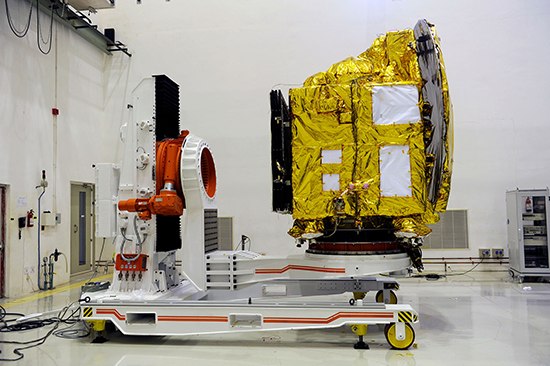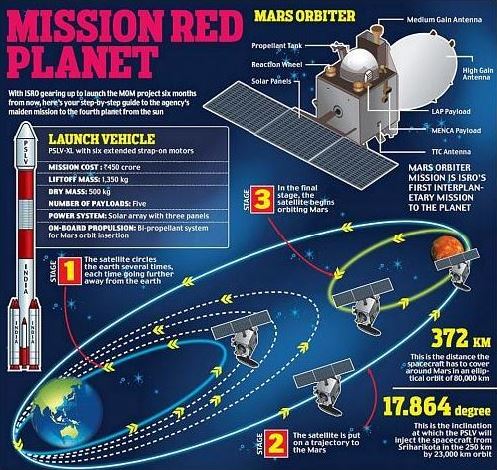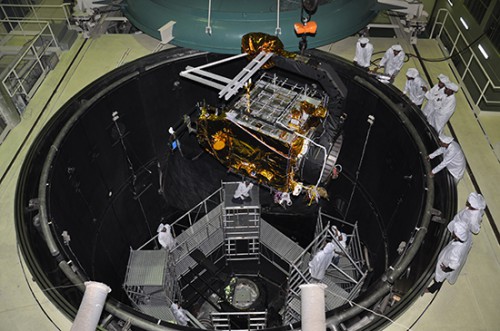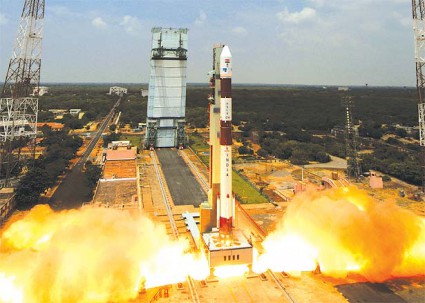
India’s first mission to Mars will remain shackled to Earth for a few more days, following reports of poor weather conditions in the post-launch tracking zone and “a snag in equipment” aboard one of the ships deployed in the Pacific Ocean to monitor the latter stages of the spacecraft’s ascent. Although the Indian Space Research Organisation (ISRO) has yet to confirm the delay officially on its website—which continues to note that the launch of the Mars Orbiter Mission (MOM), also known as “Mangalyaan” (Hindi for “Mars Craft”), will occur at some point in the 28 October-19 November timeframe—several media sources have confirmed no earlier than 6 November as the next available launch opportunity.
Despite the recent ravages of Cyclone Phailin, which wreaked devastation on large areas of India, together with Thailand, Myanmar, and Nepal, preparations for the long-awaited mission have proceeded without incident at the Satish Dhawan Space Centre, on the barrier island of Sriharikota, in the southern state of Andhra Pradesh. Although this region escaped the worst of Phailin’s wrath, more than 64,000 people had to be evacuated from low-lying areas of Andhra Pradesh at the height of the cyclone. Integration of the four-stage Polar Satellite Launch Vehicle (PSLV) has been completed, and on 17 October the Launch Authorisation Board met to approve the installation of MOM/Mangalyaan atop the rocket. ISRO Chairman Dr. K. Radhakrishnan told India’s Hindi-language NDTV news channel Saturday that the spacecraft had been fueled and was in the process of being mated to the rocket. However, the Deccan Chronicle explained that the Launch Authorisation Board had “met inconclusively” and would meet again on Tuesday, 22 October.
In the meantime, the scheduled Saturday, 19 October arrival of Marine Vessel (MV) SCI Nalanda—the main ISRO ship to be stationed in the Pacific to monitor the PSLV’s ascent—was delayed, due to bad weather. According to The Hindu newspaper, a second ship, MV SCI Yamuna, is already in Fiji. Both vessels have been provided by the Shipping Corporation of India. “The two ships, deployed last month, carry tracking terminals and are a crucial link in relaying real-time data about the last stages of the launch and release of the spacecraft, which will happen over the South Pacific,” it was noted Saturday. Quoting Deviprasad Karnik, ISRO’s Director for Press & Public Relations, The Hindu revealed that the Nalanda should reach Fiji today (Monday) and ISRO will decide an exact launch date tomorrow (Tuesday).

After its arrival, both the Nalanda and the Yamuna will undergo a period of testing, ahead of being directed to their operational positions for the impending mission. According to the Fiji Times, the Nalanda “is required to be located around 19 degrees South latitude and 160 degrees West longitude,” whilst the Yamuna will operate at 20 degrees South latitude and 130 degrees West longitude. When they are both on-station, the two ships will be about 3,450 miles (5,550 km) apart … and will both reside more than 10,350 miles (16,650 km) from India. “For any ship to travel such a long distance at one shot,” explained Vinod Kumar, India’s High Commissioner to Fiji, “is very difficult and impractical.”
Mr. Kumar added that the strategic location of Fiji and its capital, the port city of Suva, served the ISRO vessels “as a source for topping up the essential commodities … and facilitating the refueling of the ships to enable these ships to sail further.” The archipelago lies in the southwest Pacific Ocean, about 1,300 miles (2,000 km) northeast of New Zealand’s North Island, and will play a critical role in MOM/Mangalyaan’s ascent to orbit. The ignition of the PSLV’s fourth-stage motor—and injection of the spacecraft into space—is anticipated to occur somewhere high above Fijian airspace. As part of goodwill gestures between the two nations, India planned to present a model of the rocket and the Mars probe to Fiji’s president, Epeli Nailatikau.
In addition to the weather issues, a number of technical difficulties were highlighted by India’s Deccan Chronicle on Sunday. Noting “a snag in equipment on-board one of the ships,” the Chronicle elaborated that a new launch date would be officially announced “after reviewing the readiness of communication terminals” aboard the Nalanda and the Yamuna. ISRO Chairman Dr. Radhakrishnan said that the movement of Indian ships in the Pacific has slowed significantly, due the bad weather, and a decision on the date of the launch can possibly be taken on Tuesday, October 22, after the Nalanda’s arrival in Fiji.
MOM/Mangalyaan is a highly ambitious—and almost unlikely—mission for the world’s second most populous nation, having only received formal approval and a $41 million financial allocation from the Indian government in August 2012. With estimated costs as high as $100 million, the mission unsurprisingly drew criticism last year from those who pointed to India’s power failures and the risk of drought in the aftermath of weak monsoon rains. Quoted by the BBC, one Indian government official bit back at the critics. “If we don’t dare dream big, it would leave us as hewers of wood and drawers of water,” the official declared. “India is today too big to be just living on the fringes of high technology.”

Described as “a technology demonstration project,” MOM/Mangalyaan’s primary task is to prove that India has the technical capability to design, plan, manage, launch, and operate a deep-space mission across the vast gulf to reach the Red Planet. The spacecraft carries a payload of five scientific instruments—the Methane Sensor for Mars (MSM), Mars Colour Camera (MCC), Mars Exospheric Neutral Composition Analyzer (MENCA), Thermal Infrared Spectrometer (TIR), and Lyman-Alpha Photometer (LAP)—and will be dedicated to developing a clearer understanding the morphology, topography, and mineralogy of the Martian surface, the dynamics of its tenuous upper atmosphere, the effects of the solar wind and radiation, and the nature of the planet’s large moon, Phobos.
Liftoff of the mission remains scheduled within a month-long Mars “launch window,” which extends from 21 October until 19 November, and after a national committee of experts—including professors from the Indian Institute of Science at Bangalore and the famed Indian aerospace scientist and fluid dynamicist Roddam Narasimha—gave the formal go-ahead, it was announced on 22 September that the flight would begin, weather permitting, on “the first available opportunity” on 28 October. According to Spaceflight Now, the launch window opens at 4:15 p.m. local time (6:45 a.m. EDT). Assembly of the PSLV rocket at the Sriharikota launch site began in early August and is now complete and awaiting tomorrow’s planned integration of the MOM/Mangalyaan payload.
Developed and operated by ISRO, the PSLV is one of the most reliable members of India’s fleet of launch vehicles. Standing 144 feet (44 meters) tall, the four-stage rocket has the potential to deliver payloads weighing up to 7,160 pounds (3,250 kg) into low-Earth orbit and up to 3,100 pounds (1,410 kg) into geostationary transfer orbit and is therefore ideally suited to boost the fully-fueled 2,980-pound (1,350-kg) MOM/Mangalyaan spacecraft aloft. First flown in September 1993, PSLV has completed 24 missions, of which one—ironically the rocket’s maiden voyage—suffered an attitude-control failure during the separation of its second and third stages, crashing into the Bay of Bengal 700 seconds after liftoff. Another experienced an underperformance of its fourth stage during a September 1997 launch, but every other flight has been flawless.

The MOM/Mangalyaan mission will ride aboard the uprated PSLV-XL, which made its inaugural flight in October 2008, carrying Chandrayaan-1, India’s first spacecraft to visit the Moon. The vehicle will be powered for the first portion of its flight by a single first-stage engine and six strap-on boosters, all of which utilize a solid fuel of hydroxyl-terminated polybutadiene. Although the boosters will burn for just 44 seconds, the first stage will continue to drive the PSLV-XL uphill for the first 4.5 minutes of the mission. The second stage and its single Vikas liquid-fueled engine will take over for 2.5 minutes, followed by the solid-fueled third stage for 83 seconds and lastly the twin liquid-fueled motors of the fourth stage for a little over 7 minutes. Throughout its history, variants of the PSLV have delivered payloads into orbit on behalf of India, Germany, South Korea, Norway, Italy, Luxembourg, Indonesia, Argentina, Israel, Canada, Japan, the Netherlands, Denmark, Switzerland, Turkey, Algeria, Singapore, Russia, Austria, the United Kingdom, and France. On its most recent launch, on 1 July 2013, it successfully delivered the IRNSS-1A payload into orbit for the Indian Regional Navigational Satellite System.
After the PSLV-XL has placed MOM/Mangalyaan into low-Earth orbit, the spacecraft will execute a series of six thruster firings to expand its orbit to an apogee of 133,600 miles (215,000 km) and a perigee of 370 miles (600 km). Its Liquid Apogee Motor (LAM), fueled by monomethyl hydrazine and nitrogen tetroxide, was successfully tested in October 2012 at ISRO’s Liquid Propulsion Systems Centre at Mahendra Giri in Tamil Nadu. It will remain in this highly elliptical orbit for about a month, ahead of a final burn on 27 November to place it onto a trans-Mars trajectory. The spacecraft will cruise through interplanetary space for 10 months, with the LAM burns to enter an elliptical orbit of 310 x 50,000 miles (500 x 80,000 km) around the Red Planet currently scheduled for 21 September 2014.
India is still riding on the success of Chandrayaan-1, its first mission to the Moon, in 2008, which returned valuable data about the presence of large deposits of liquid water in the lunar interior. India is presently working toward a multi-faceted Chandrayaan-2, which is scheduled to launch a lunar orbiter, lander, and roving vehicle sometime in 2015, and if the MOM/Mangalyaan mission proves successful, it will make ISRO the fourth national space agency—after Roscosmos, NASA, and the European Space Agency (ESA)—to fly its own mission to the Red Planet.
Want to keep up-to-date with all things space? Be sure to “Like” AmericaSpace on Facebook and follow us on Twitter: @AmericaSpace



